Pearson BTEC L5 Destination Management Services Report - Analysis
VerifiedAdded on 2023/01/09
|18
|5561
|38
Report
AI Summary
This report provides a comprehensive analysis of destination management services, exploring global destinations such as Australia, Italy, and Nepal. It delves into the common features and characteristics of these destinations, including attractions, accessibility, accommodation, and amenities. The report assesses core resources, analyzes destination characteristics, and critically evaluates key aspects. Part 2 focuses on the concept of destination management, its key benefits and objectives, and the role of destination management organizations (DMOs) at national, regional, and local levels. It includes a critical analysis of DMO performance and offers recommendations for improvement. Part 3 evaluates the destination life cycle and its implications on destination management, appraising the role of management at different stages and critically evaluating DMO priorities. The report concludes with justified recommendations for improvements across various aspects of destination management.
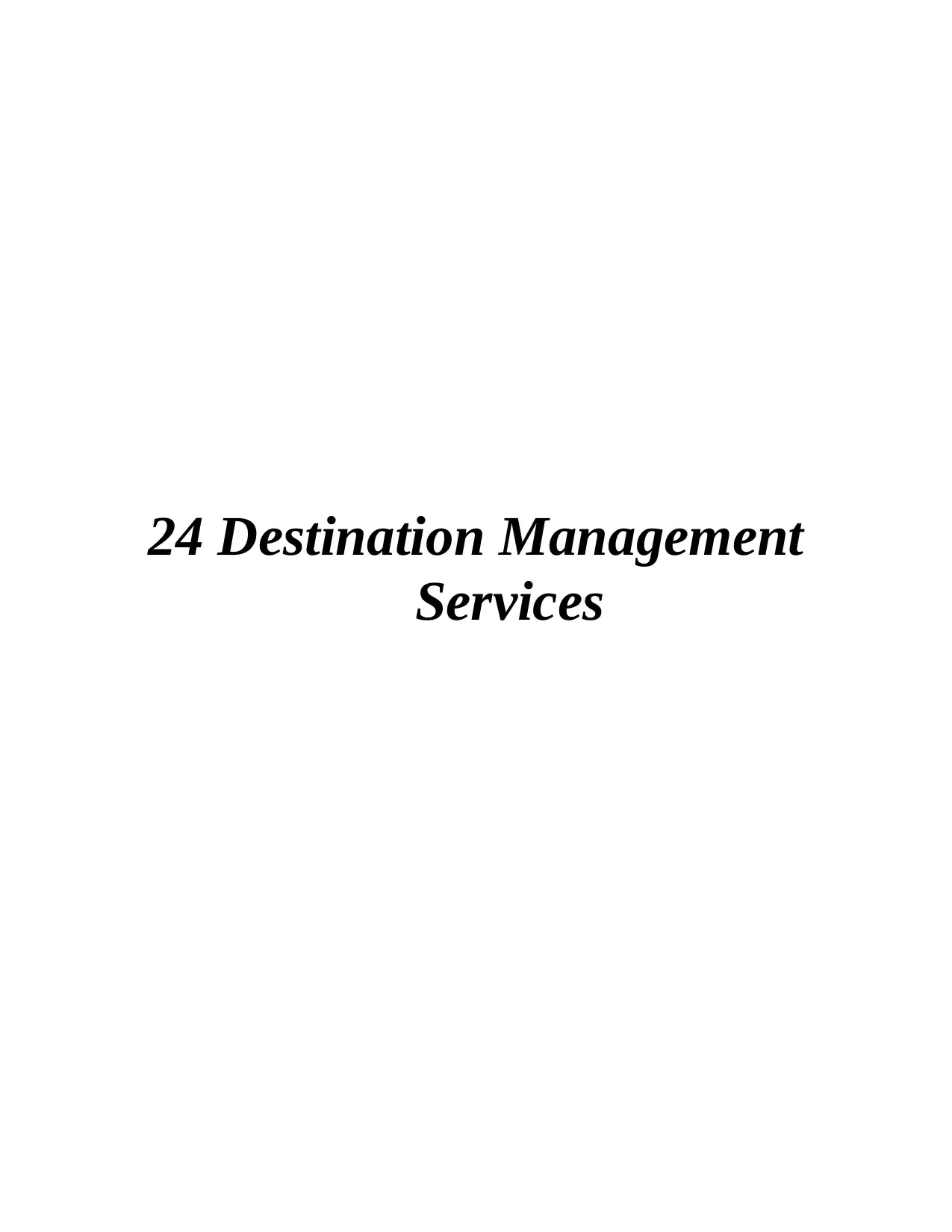
24 Destination Management
Services
Services
Paraphrase This Document
Need a fresh take? Get an instant paraphrase of this document with our AI Paraphraser
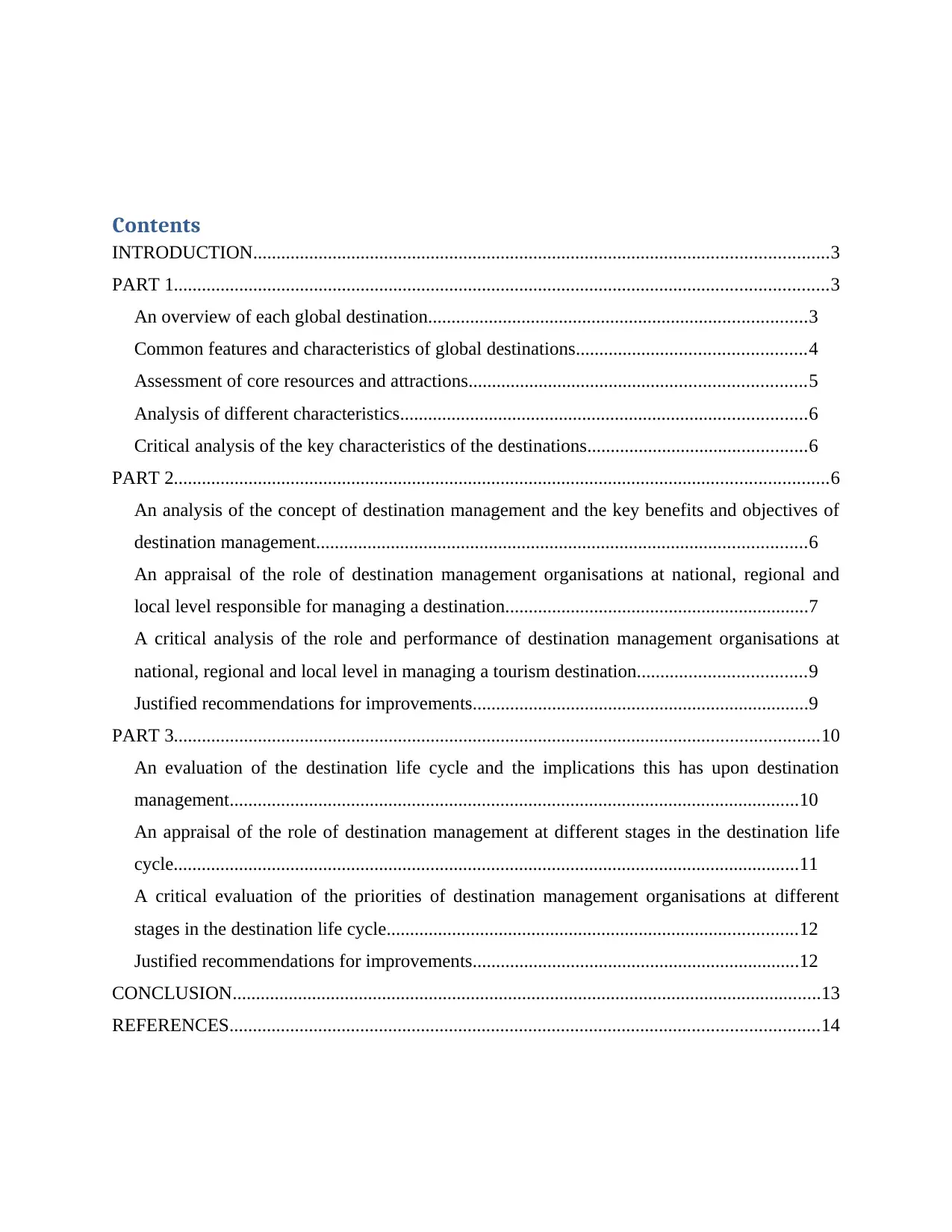
Contents
INTRODUCTION...........................................................................................................................3
PART 1............................................................................................................................................3
An overview of each global destination.................................................................................3
Common features and characteristics of global destinations.................................................4
Assessment of core resources and attractions........................................................................5
Analysis of different characteristics.......................................................................................6
Critical analysis of the key characteristics of the destinations...............................................6
PART 2............................................................................................................................................6
An analysis of the concept of destination management and the key benefits and objectives of
destination management.........................................................................................................6
An appraisal of the role of destination management organisations at national, regional and
local level responsible for managing a destination.................................................................7
A critical analysis of the role and performance of destination management organisations at
national, regional and local level in managing a tourism destination....................................9
Justified recommendations for improvements........................................................................9
PART 3..........................................................................................................................................10
An evaluation of the destination life cycle and the implications this has upon destination
management..........................................................................................................................10
An appraisal of the role of destination management at different stages in the destination life
cycle......................................................................................................................................11
A critical evaluation of the priorities of destination management organisations at different
stages in the destination life cycle........................................................................................12
Justified recommendations for improvements......................................................................12
CONCLUSION..............................................................................................................................13
REFERENCES..............................................................................................................................14
INTRODUCTION...........................................................................................................................3
PART 1............................................................................................................................................3
An overview of each global destination.................................................................................3
Common features and characteristics of global destinations.................................................4
Assessment of core resources and attractions........................................................................5
Analysis of different characteristics.......................................................................................6
Critical analysis of the key characteristics of the destinations...............................................6
PART 2............................................................................................................................................6
An analysis of the concept of destination management and the key benefits and objectives of
destination management.........................................................................................................6
An appraisal of the role of destination management organisations at national, regional and
local level responsible for managing a destination.................................................................7
A critical analysis of the role and performance of destination management organisations at
national, regional and local level in managing a tourism destination....................................9
Justified recommendations for improvements........................................................................9
PART 3..........................................................................................................................................10
An evaluation of the destination life cycle and the implications this has upon destination
management..........................................................................................................................10
An appraisal of the role of destination management at different stages in the destination life
cycle......................................................................................................................................11
A critical evaluation of the priorities of destination management organisations at different
stages in the destination life cycle........................................................................................12
Justified recommendations for improvements......................................................................12
CONCLUSION..............................................................................................................................13
REFERENCES..............................................................................................................................14

⊘ This is a preview!⊘
Do you want full access?
Subscribe today to unlock all pages.

Trusted by 1+ million students worldwide
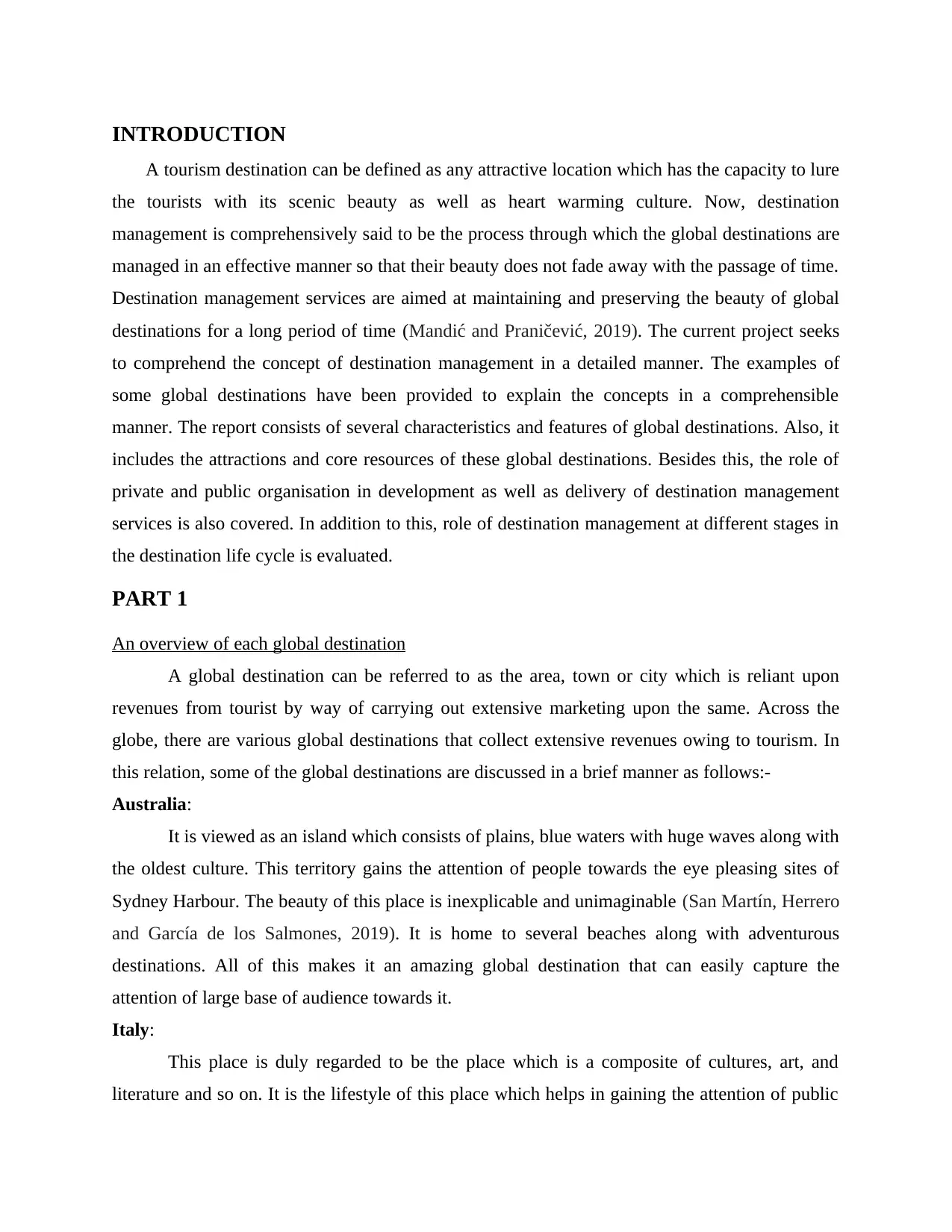
INTRODUCTION
A tourism destination can be defined as any attractive location which has the capacity to lure
the tourists with its scenic beauty as well as heart warming culture. Now, destination
management is comprehensively said to be the process through which the global destinations are
managed in an effective manner so that their beauty does not fade away with the passage of time.
Destination management services are aimed at maintaining and preserving the beauty of global
destinations for a long period of time (Mandić and Praničević, 2019). The current project seeks
to comprehend the concept of destination management in a detailed manner. The examples of
some global destinations have been provided to explain the concepts in a comprehensible
manner. The report consists of several characteristics and features of global destinations. Also, it
includes the attractions and core resources of these global destinations. Besides this, the role of
private and public organisation in development as well as delivery of destination management
services is also covered. In addition to this, role of destination management at different stages in
the destination life cycle is evaluated.
PART 1
An overview of each global destination
A global destination can be referred to as the area, town or city which is reliant upon
revenues from tourist by way of carrying out extensive marketing upon the same. Across the
globe, there are various global destinations that collect extensive revenues owing to tourism. In
this relation, some of the global destinations are discussed in a brief manner as follows:-
Australia:
It is viewed as an island which consists of plains, blue waters with huge waves along with
the oldest culture. This territory gains the attention of people towards the eye pleasing sites of
Sydney Harbour. The beauty of this place is inexplicable and unimaginable (San Martín, Herrero
and García de los Salmones, 2019). It is home to several beaches along with adventurous
destinations. All of this makes it an amazing global destination that can easily capture the
attention of large base of audience towards it.
Italy:
This place is duly regarded to be the place which is a composite of cultures, art, and
literature and so on. It is the lifestyle of this place which helps in gaining the attention of public
A tourism destination can be defined as any attractive location which has the capacity to lure
the tourists with its scenic beauty as well as heart warming culture. Now, destination
management is comprehensively said to be the process through which the global destinations are
managed in an effective manner so that their beauty does not fade away with the passage of time.
Destination management services are aimed at maintaining and preserving the beauty of global
destinations for a long period of time (Mandić and Praničević, 2019). The current project seeks
to comprehend the concept of destination management in a detailed manner. The examples of
some global destinations have been provided to explain the concepts in a comprehensible
manner. The report consists of several characteristics and features of global destinations. Also, it
includes the attractions and core resources of these global destinations. Besides this, the role of
private and public organisation in development as well as delivery of destination management
services is also covered. In addition to this, role of destination management at different stages in
the destination life cycle is evaluated.
PART 1
An overview of each global destination
A global destination can be referred to as the area, town or city which is reliant upon
revenues from tourist by way of carrying out extensive marketing upon the same. Across the
globe, there are various global destinations that collect extensive revenues owing to tourism. In
this relation, some of the global destinations are discussed in a brief manner as follows:-
Australia:
It is viewed as an island which consists of plains, blue waters with huge waves along with
the oldest culture. This territory gains the attention of people towards the eye pleasing sites of
Sydney Harbour. The beauty of this place is inexplicable and unimaginable (San Martín, Herrero
and García de los Salmones, 2019). It is home to several beaches along with adventurous
destinations. All of this makes it an amazing global destination that can easily capture the
attention of large base of audience towards it.
Italy:
This place is duly regarded to be the place which is a composite of cultures, art, and
literature and so on. It is the lifestyle of this place which helps in gaining the attention of public
Paraphrase This Document
Need a fresh take? Get an instant paraphrase of this document with our AI Paraphraser
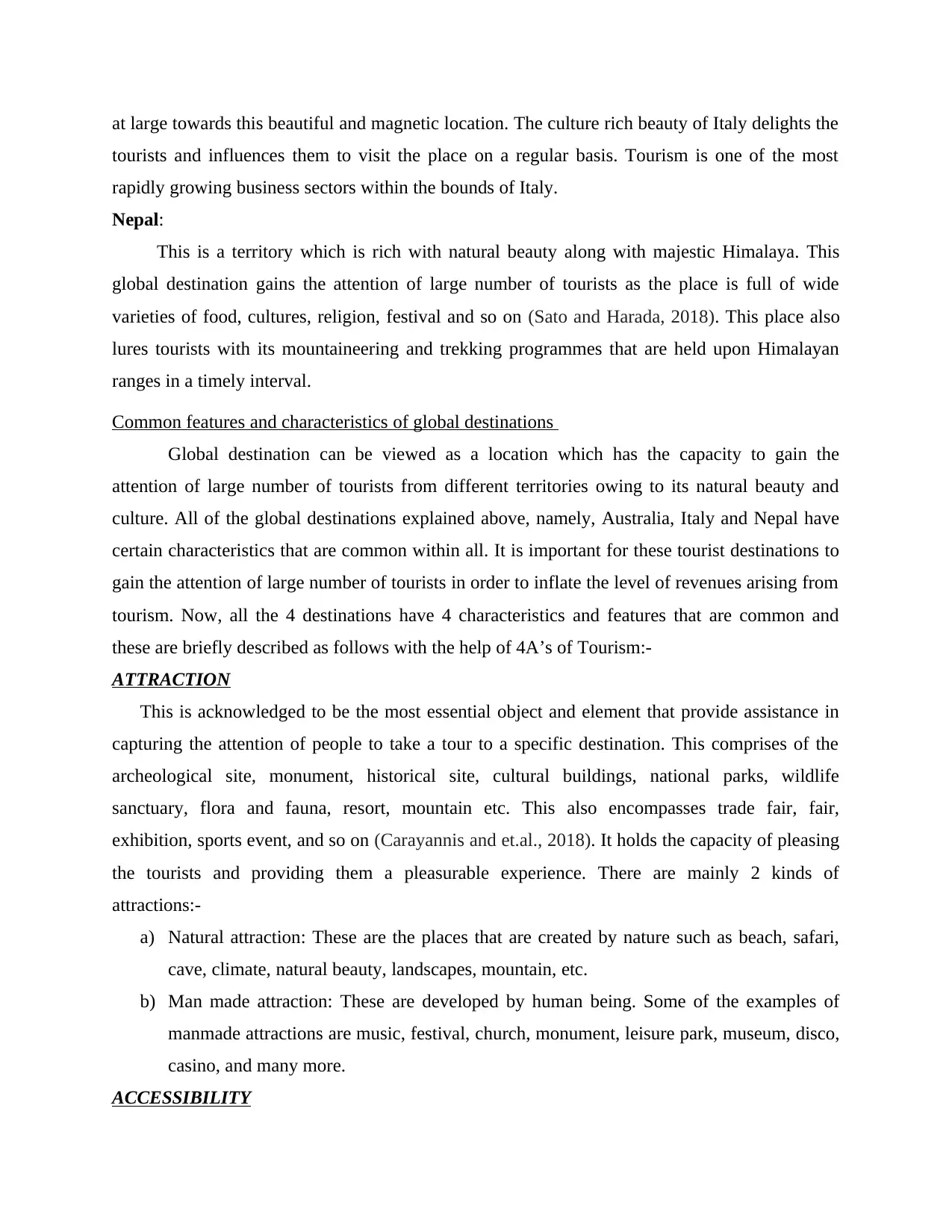
at large towards this beautiful and magnetic location. The culture rich beauty of Italy delights the
tourists and influences them to visit the place on a regular basis. Tourism is one of the most
rapidly growing business sectors within the bounds of Italy.
Nepal:
This is a territory which is rich with natural beauty along with majestic Himalaya. This
global destination gains the attention of large number of tourists as the place is full of wide
varieties of food, cultures, religion, festival and so on (Sato and Harada, 2018). This place also
lures tourists with its mountaineering and trekking programmes that are held upon Himalayan
ranges in a timely interval.
Common features and characteristics of global destinations
Global destination can be viewed as a location which has the capacity to gain the
attention of large number of tourists from different territories owing to its natural beauty and
culture. All of the global destinations explained above, namely, Australia, Italy and Nepal have
certain characteristics that are common within all. It is important for these tourist destinations to
gain the attention of large number of tourists in order to inflate the level of revenues arising from
tourism. Now, all the 4 destinations have 4 characteristics and features that are common and
these are briefly described as follows with the help of 4A’s of Tourism:-
ATTRACTION
This is acknowledged to be the most essential object and element that provide assistance in
capturing the attention of people to take a tour to a specific destination. This comprises of the
archeological site, monument, historical site, cultural buildings, national parks, wildlife
sanctuary, flora and fauna, resort, mountain etc. This also encompasses trade fair, fair,
exhibition, sports event, and so on (Carayannis and et.al., 2018). It holds the capacity of pleasing
the tourists and providing them a pleasurable experience. There are mainly 2 kinds of
attractions:-
a) Natural attraction: These are the places that are created by nature such as beach, safari,
cave, climate, natural beauty, landscapes, mountain, etc.
b) Man made attraction: These are developed by human being. Some of the examples of
manmade attractions are music, festival, church, monument, leisure park, museum, disco,
casino, and many more.
ACCESSIBILITY
tourists and influences them to visit the place on a regular basis. Tourism is one of the most
rapidly growing business sectors within the bounds of Italy.
Nepal:
This is a territory which is rich with natural beauty along with majestic Himalaya. This
global destination gains the attention of large number of tourists as the place is full of wide
varieties of food, cultures, religion, festival and so on (Sato and Harada, 2018). This place also
lures tourists with its mountaineering and trekking programmes that are held upon Himalayan
ranges in a timely interval.
Common features and characteristics of global destinations
Global destination can be viewed as a location which has the capacity to gain the
attention of large number of tourists from different territories owing to its natural beauty and
culture. All of the global destinations explained above, namely, Australia, Italy and Nepal have
certain characteristics that are common within all. It is important for these tourist destinations to
gain the attention of large number of tourists in order to inflate the level of revenues arising from
tourism. Now, all the 4 destinations have 4 characteristics and features that are common and
these are briefly described as follows with the help of 4A’s of Tourism:-
ATTRACTION
This is acknowledged to be the most essential object and element that provide assistance in
capturing the attention of people to take a tour to a specific destination. This comprises of the
archeological site, monument, historical site, cultural buildings, national parks, wildlife
sanctuary, flora and fauna, resort, mountain etc. This also encompasses trade fair, fair,
exhibition, sports event, and so on (Carayannis and et.al., 2018). It holds the capacity of pleasing
the tourists and providing them a pleasurable experience. There are mainly 2 kinds of
attractions:-
a) Natural attraction: These are the places that are created by nature such as beach, safari,
cave, climate, natural beauty, landscapes, mountain, etc.
b) Man made attraction: These are developed by human being. Some of the examples of
manmade attractions are music, festival, church, monument, leisure park, museum, disco,
casino, and many more.
ACCESSIBILITY
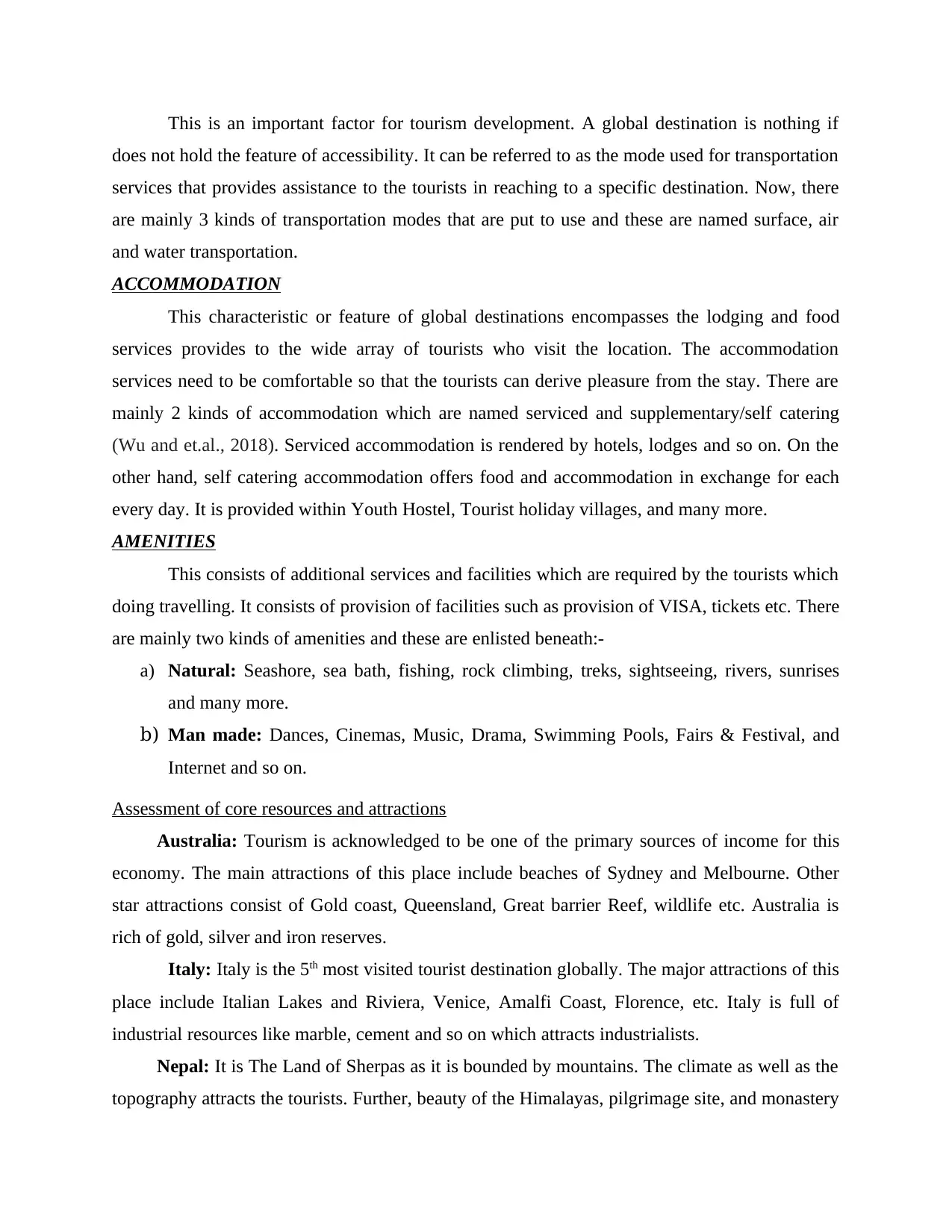
This is an important factor for tourism development. A global destination is nothing if
does not hold the feature of accessibility. It can be referred to as the mode used for transportation
services that provides assistance to the tourists in reaching to a specific destination. Now, there
are mainly 3 kinds of transportation modes that are put to use and these are named surface, air
and water transportation.
ACCOMMODATION
This characteristic or feature of global destinations encompasses the lodging and food
services provides to the wide array of tourists who visit the location. The accommodation
services need to be comfortable so that the tourists can derive pleasure from the stay. There are
mainly 2 kinds of accommodation which are named serviced and supplementary/self catering
(Wu and et.al., 2018). Serviced accommodation is rendered by hotels, lodges and so on. On the
other hand, self catering accommodation offers food and accommodation in exchange for each
every day. It is provided within Youth Hostel, Tourist holiday villages, and many more.
AMENITIES
This consists of additional services and facilities which are required by the tourists which
doing travelling. It consists of provision of facilities such as provision of VISA, tickets etc. There
are mainly two kinds of amenities and these are enlisted beneath:-
a) Natural: Seashore, sea bath, fishing, rock climbing, treks, sightseeing, rivers, sunrises
and many more.
b) Man made: Dances, Cinemas, Music, Drama, Swimming Pools, Fairs & Festival, and
Internet and so on.
Assessment of core resources and attractions
Australia: Tourism is acknowledged to be one of the primary sources of income for this
economy. The main attractions of this place include beaches of Sydney and Melbourne. Other
star attractions consist of Gold coast, Queensland, Great barrier Reef, wildlife etc. Australia is
rich of gold, silver and iron reserves.
Italy: Italy is the 5th most visited tourist destination globally. The major attractions of this
place include Italian Lakes and Riviera, Venice, Amalfi Coast, Florence, etc. Italy is full of
industrial resources like marble, cement and so on which attracts industrialists.
Nepal: It is The Land of Sherpas as it is bounded by mountains. The climate as well as the
topography attracts the tourists. Further, beauty of the Himalayas, pilgrimage site, and monastery
does not hold the feature of accessibility. It can be referred to as the mode used for transportation
services that provides assistance to the tourists in reaching to a specific destination. Now, there
are mainly 3 kinds of transportation modes that are put to use and these are named surface, air
and water transportation.
ACCOMMODATION
This characteristic or feature of global destinations encompasses the lodging and food
services provides to the wide array of tourists who visit the location. The accommodation
services need to be comfortable so that the tourists can derive pleasure from the stay. There are
mainly 2 kinds of accommodation which are named serviced and supplementary/self catering
(Wu and et.al., 2018). Serviced accommodation is rendered by hotels, lodges and so on. On the
other hand, self catering accommodation offers food and accommodation in exchange for each
every day. It is provided within Youth Hostel, Tourist holiday villages, and many more.
AMENITIES
This consists of additional services and facilities which are required by the tourists which
doing travelling. It consists of provision of facilities such as provision of VISA, tickets etc. There
are mainly two kinds of amenities and these are enlisted beneath:-
a) Natural: Seashore, sea bath, fishing, rock climbing, treks, sightseeing, rivers, sunrises
and many more.
b) Man made: Dances, Cinemas, Music, Drama, Swimming Pools, Fairs & Festival, and
Internet and so on.
Assessment of core resources and attractions
Australia: Tourism is acknowledged to be one of the primary sources of income for this
economy. The main attractions of this place include beaches of Sydney and Melbourne. Other
star attractions consist of Gold coast, Queensland, Great barrier Reef, wildlife etc. Australia is
rich of gold, silver and iron reserves.
Italy: Italy is the 5th most visited tourist destination globally. The major attractions of this
place include Italian Lakes and Riviera, Venice, Amalfi Coast, Florence, etc. Italy is full of
industrial resources like marble, cement and so on which attracts industrialists.
Nepal: It is The Land of Sherpas as it is bounded by mountains. The climate as well as the
topography attracts the tourists. Further, beauty of the Himalayas, pilgrimage site, and monastery
⊘ This is a preview!⊘
Do you want full access?
Subscribe today to unlock all pages.

Trusted by 1+ million students worldwide
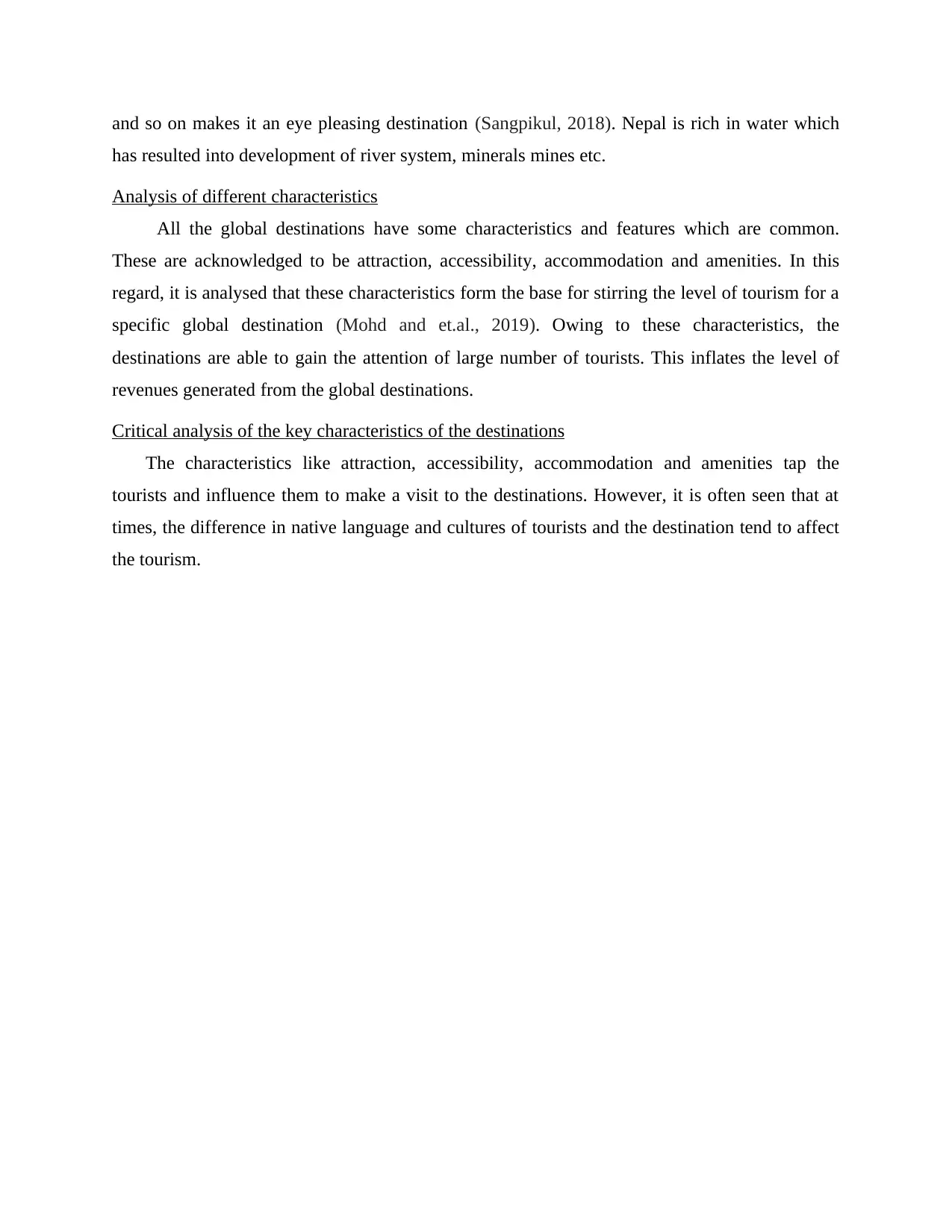
and so on makes it an eye pleasing destination (Sangpikul, 2018). Nepal is rich in water which
has resulted into development of river system, minerals mines etc.
Analysis of different characteristics
All the global destinations have some characteristics and features which are common.
These are acknowledged to be attraction, accessibility, accommodation and amenities. In this
regard, it is analysed that these characteristics form the base for stirring the level of tourism for a
specific global destination (Mohd and et.al., 2019). Owing to these characteristics, the
destinations are able to gain the attention of large number of tourists. This inflates the level of
revenues generated from the global destinations.
Critical analysis of the key characteristics of the destinations
The characteristics like attraction, accessibility, accommodation and amenities tap the
tourists and influence them to make a visit to the destinations. However, it is often seen that at
times, the difference in native language and cultures of tourists and the destination tend to affect
the tourism.
has resulted into development of river system, minerals mines etc.
Analysis of different characteristics
All the global destinations have some characteristics and features which are common.
These are acknowledged to be attraction, accessibility, accommodation and amenities. In this
regard, it is analysed that these characteristics form the base for stirring the level of tourism for a
specific global destination (Mohd and et.al., 2019). Owing to these characteristics, the
destinations are able to gain the attention of large number of tourists. This inflates the level of
revenues generated from the global destinations.
Critical analysis of the key characteristics of the destinations
The characteristics like attraction, accessibility, accommodation and amenities tap the
tourists and influence them to make a visit to the destinations. However, it is often seen that at
times, the difference in native language and cultures of tourists and the destination tend to affect
the tourism.
Paraphrase This Document
Need a fresh take? Get an instant paraphrase of this document with our AI Paraphraser

PART 2
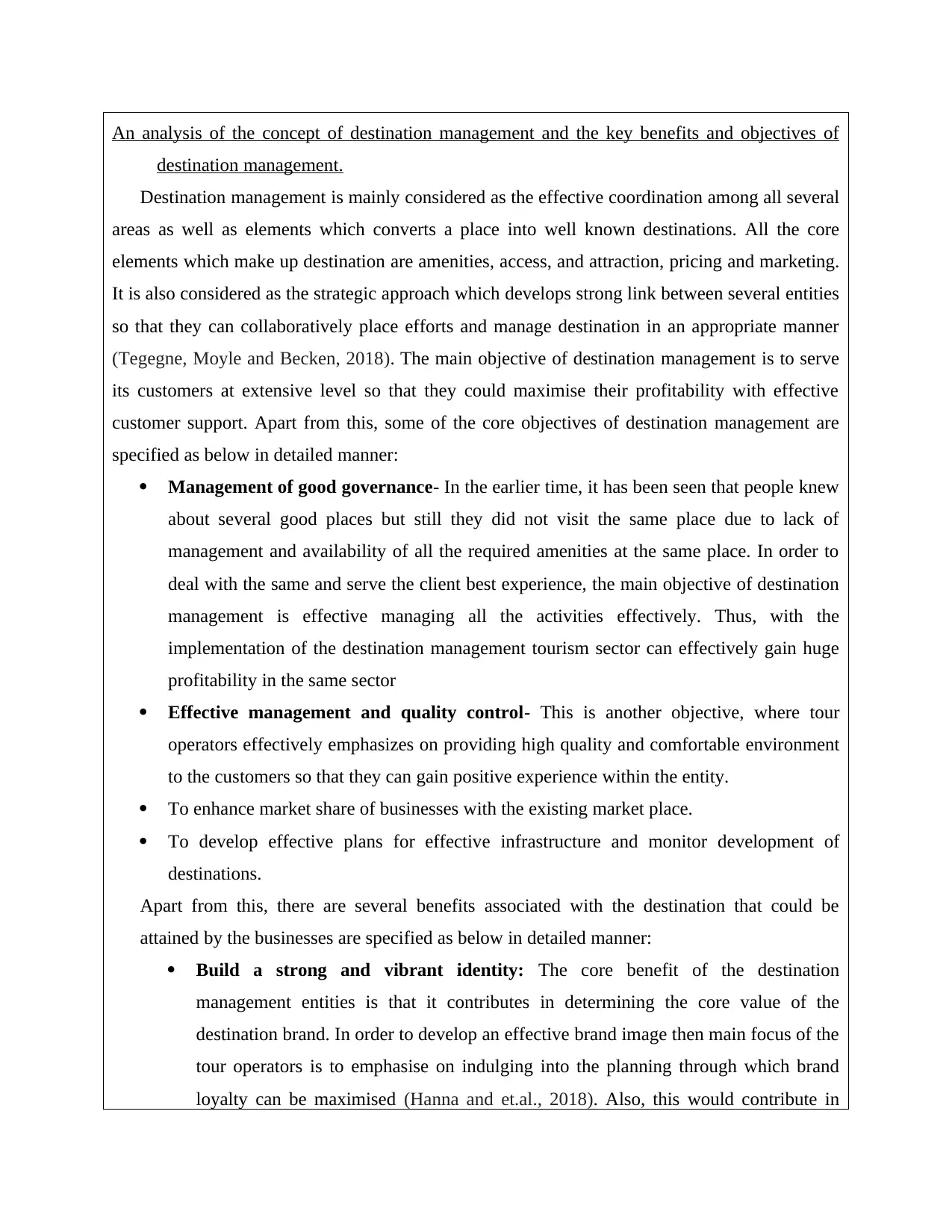
An analysis of the concept of destination management and the key benefits and objectives of
destination management.
Destination management is mainly considered as the effective coordination among all several
areas as well as elements which converts a place into well known destinations. All the core
elements which make up destination are amenities, access, and attraction, pricing and marketing.
It is also considered as the strategic approach which develops strong link between several entities
so that they can collaboratively place efforts and manage destination in an appropriate manner
(Tegegne, Moyle and Becken, 2018). The main objective of destination management is to serve
its customers at extensive level so that they could maximise their profitability with effective
customer support. Apart from this, some of the core objectives of destination management are
specified as below in detailed manner:
Management of good governance- In the earlier time, it has been seen that people knew
about several good places but still they did not visit the same place due to lack of
management and availability of all the required amenities at the same place. In order to
deal with the same and serve the client best experience, the main objective of destination
management is effective managing all the activities effectively. Thus, with the
implementation of the destination management tourism sector can effectively gain huge
profitability in the same sector
Effective management and quality control- This is another objective, where tour
operators effectively emphasizes on providing high quality and comfortable environment
to the customers so that they can gain positive experience within the entity.
To enhance market share of businesses with the existing market place.
To develop effective plans for effective infrastructure and monitor development of
destinations.
Apart from this, there are several benefits associated with the destination that could be
attained by the businesses are specified as below in detailed manner:
Build a strong and vibrant identity: The core benefit of the destination
management entities is that it contributes in determining the core value of the
destination brand. In order to develop an effective brand image then main focus of the
tour operators is to emphasise on indulging into the planning through which brand
loyalty can be maximised (Hanna and et.al., 2018). Also, this would contribute in
destination management.
Destination management is mainly considered as the effective coordination among all several
areas as well as elements which converts a place into well known destinations. All the core
elements which make up destination are amenities, access, and attraction, pricing and marketing.
It is also considered as the strategic approach which develops strong link between several entities
so that they can collaboratively place efforts and manage destination in an appropriate manner
(Tegegne, Moyle and Becken, 2018). The main objective of destination management is to serve
its customers at extensive level so that they could maximise their profitability with effective
customer support. Apart from this, some of the core objectives of destination management are
specified as below in detailed manner:
Management of good governance- In the earlier time, it has been seen that people knew
about several good places but still they did not visit the same place due to lack of
management and availability of all the required amenities at the same place. In order to
deal with the same and serve the client best experience, the main objective of destination
management is effective managing all the activities effectively. Thus, with the
implementation of the destination management tourism sector can effectively gain huge
profitability in the same sector
Effective management and quality control- This is another objective, where tour
operators effectively emphasizes on providing high quality and comfortable environment
to the customers so that they can gain positive experience within the entity.
To enhance market share of businesses with the existing market place.
To develop effective plans for effective infrastructure and monitor development of
destinations.
Apart from this, there are several benefits associated with the destination that could be
attained by the businesses are specified as below in detailed manner:
Build a strong and vibrant identity: The core benefit of the destination
management entities is that it contributes in determining the core value of the
destination brand. In order to develop an effective brand image then main focus of the
tour operators is to emphasise on indulging into the planning through which brand
loyalty can be maximised (Hanna and et.al., 2018). Also, this would contribute in
⊘ This is a preview!⊘
Do you want full access?
Subscribe today to unlock all pages.

Trusted by 1+ million students worldwide
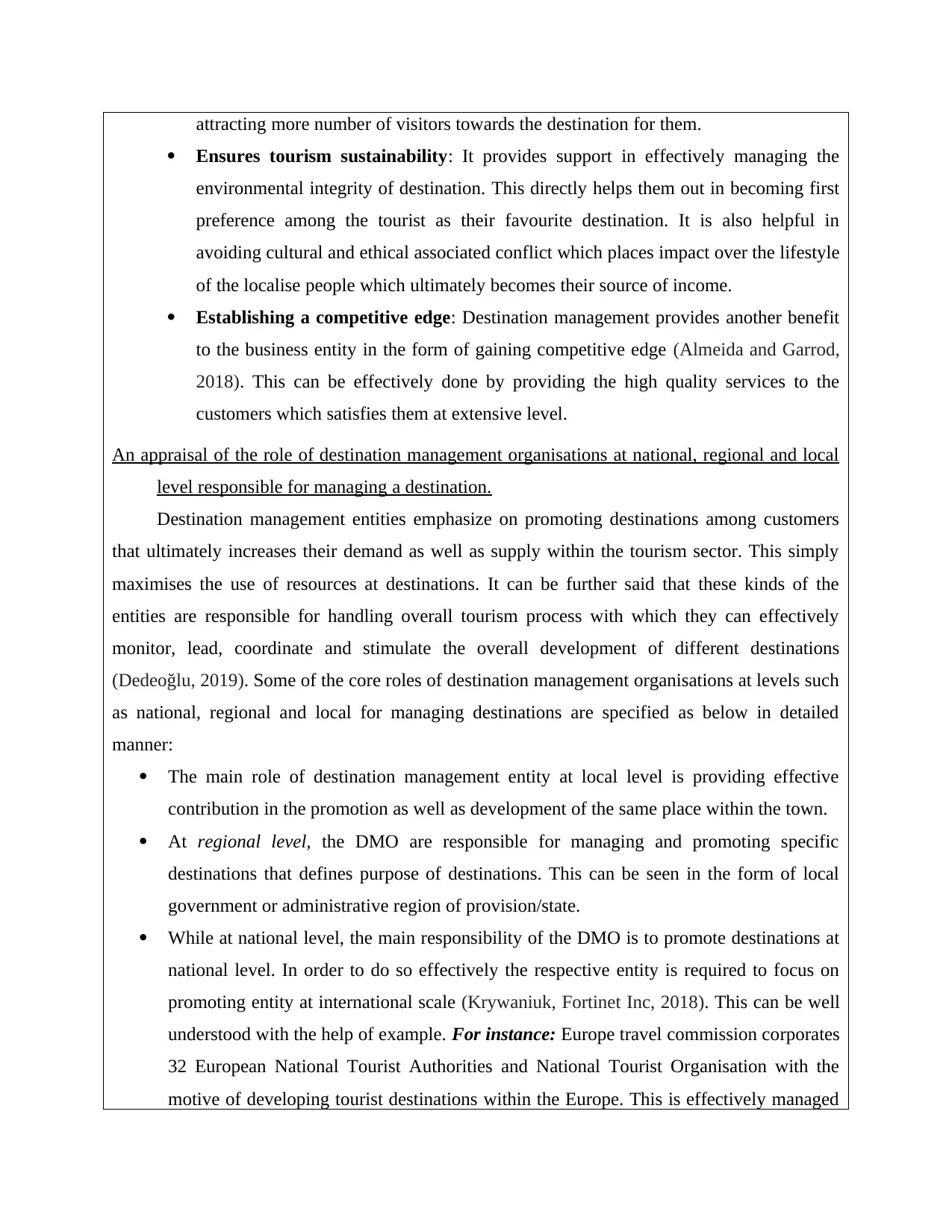
attracting more number of visitors towards the destination for them.
Ensures tourism sustainability: It provides support in effectively managing the
environmental integrity of destination. This directly helps them out in becoming first
preference among the tourist as their favourite destination. It is also helpful in
avoiding cultural and ethical associated conflict which places impact over the lifestyle
of the localise people which ultimately becomes their source of income.
Establishing a competitive edge: Destination management provides another benefit
to the business entity in the form of gaining competitive edge (Almeida and Garrod,
2018). This can be effectively done by providing the high quality services to the
customers which satisfies them at extensive level.
An appraisal of the role of destination management organisations at national, regional and local
level responsible for managing a destination.
Destination management entities emphasize on promoting destinations among customers
that ultimately increases their demand as well as supply within the tourism sector. This simply
maximises the use of resources at destinations. It can be further said that these kinds of the
entities are responsible for handling overall tourism process with which they can effectively
monitor, lead, coordinate and stimulate the overall development of different destinations
(Dedeoğlu, 2019). Some of the core roles of destination management organisations at levels such
as national, regional and local for managing destinations are specified as below in detailed
manner:
The main role of destination management entity at local level is providing effective
contribution in the promotion as well as development of the same place within the town.
At regional level, the DMO are responsible for managing and promoting specific
destinations that defines purpose of destinations. This can be seen in the form of local
government or administrative region of provision/state.
While at national level, the main responsibility of the DMO is to promote destinations at
national level. In order to do so effectively the respective entity is required to focus on
promoting entity at international scale (Krywaniuk, Fortinet Inc, 2018). This can be well
understood with the help of example. For instance: Europe travel commission corporates
32 European National Tourist Authorities and National Tourist Organisation with the
motive of developing tourist destinations within the Europe. This is effectively managed
Ensures tourism sustainability: It provides support in effectively managing the
environmental integrity of destination. This directly helps them out in becoming first
preference among the tourist as their favourite destination. It is also helpful in
avoiding cultural and ethical associated conflict which places impact over the lifestyle
of the localise people which ultimately becomes their source of income.
Establishing a competitive edge: Destination management provides another benefit
to the business entity in the form of gaining competitive edge (Almeida and Garrod,
2018). This can be effectively done by providing the high quality services to the
customers which satisfies them at extensive level.
An appraisal of the role of destination management organisations at national, regional and local
level responsible for managing a destination.
Destination management entities emphasize on promoting destinations among customers
that ultimately increases their demand as well as supply within the tourism sector. This simply
maximises the use of resources at destinations. It can be further said that these kinds of the
entities are responsible for handling overall tourism process with which they can effectively
monitor, lead, coordinate and stimulate the overall development of different destinations
(Dedeoğlu, 2019). Some of the core roles of destination management organisations at levels such
as national, regional and local for managing destinations are specified as below in detailed
manner:
The main role of destination management entity at local level is providing effective
contribution in the promotion as well as development of the same place within the town.
At regional level, the DMO are responsible for managing and promoting specific
destinations that defines purpose of destinations. This can be seen in the form of local
government or administrative region of provision/state.
While at national level, the main responsibility of the DMO is to promote destinations at
national level. In order to do so effectively the respective entity is required to focus on
promoting entity at international scale (Krywaniuk, Fortinet Inc, 2018). This can be well
understood with the help of example. For instance: Europe travel commission corporates
32 European National Tourist Authorities and National Tourist Organisation with the
motive of developing tourist destinations within the Europe. This is effectively managed
Paraphrase This Document
Need a fresh take? Get an instant paraphrase of this document with our AI Paraphraser
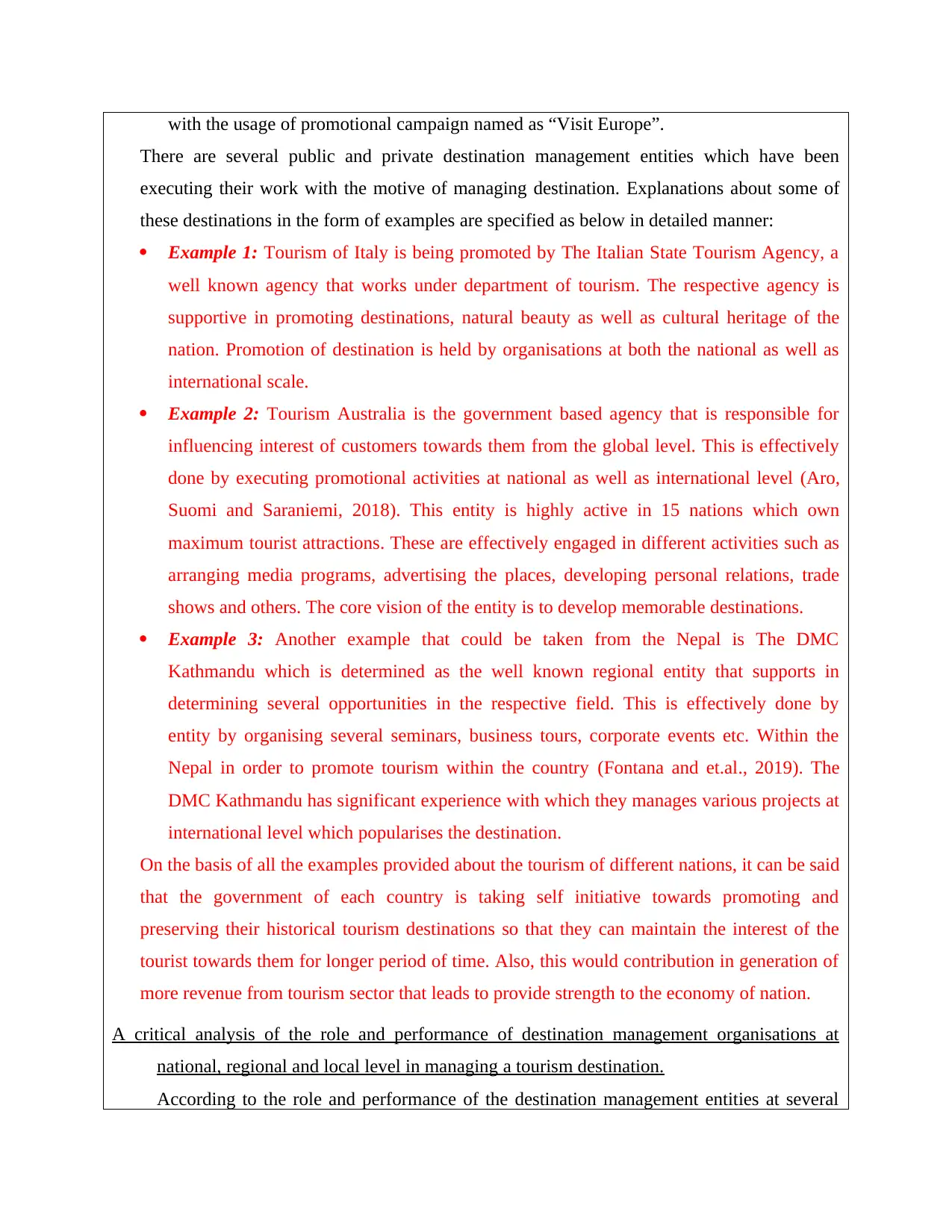
with the usage of promotional campaign named as “Visit Europe”.
There are several public and private destination management entities which have been
executing their work with the motive of managing destination. Explanations about some of
these destinations in the form of examples are specified as below in detailed manner:
Example 1: Tourism of Italy is being promoted by The Italian State Tourism Agency, a
well known agency that works under department of tourism. The respective agency is
supportive in promoting destinations, natural beauty as well as cultural heritage of the
nation. Promotion of destination is held by organisations at both the national as well as
international scale.
Example 2: Tourism Australia is the government based agency that is responsible for
influencing interest of customers towards them from the global level. This is effectively
done by executing promotional activities at national as well as international level (Aro,
Suomi and Saraniemi, 2018). This entity is highly active in 15 nations which own
maximum tourist attractions. These are effectively engaged in different activities such as
arranging media programs, advertising the places, developing personal relations, trade
shows and others. The core vision of the entity is to develop memorable destinations.
Example 3: Another example that could be taken from the Nepal is The DMC
Kathmandu which is determined as the well known regional entity that supports in
determining several opportunities in the respective field. This is effectively done by
entity by organising several seminars, business tours, corporate events etc. Within the
Nepal in order to promote tourism within the country (Fontana and et.al., 2019). The
DMC Kathmandu has significant experience with which they manages various projects at
international level which popularises the destination.
On the basis of all the examples provided about the tourism of different nations, it can be said
that the government of each country is taking self initiative towards promoting and
preserving their historical tourism destinations so that they can maintain the interest of the
tourist towards them for longer period of time. Also, this would contribution in generation of
more revenue from tourism sector that leads to provide strength to the economy of nation.
A critical analysis of the role and performance of destination management organisations at
national, regional and local level in managing a tourism destination.
According to the role and performance of the destination management entities at several
There are several public and private destination management entities which have been
executing their work with the motive of managing destination. Explanations about some of
these destinations in the form of examples are specified as below in detailed manner:
Example 1: Tourism of Italy is being promoted by The Italian State Tourism Agency, a
well known agency that works under department of tourism. The respective agency is
supportive in promoting destinations, natural beauty as well as cultural heritage of the
nation. Promotion of destination is held by organisations at both the national as well as
international scale.
Example 2: Tourism Australia is the government based agency that is responsible for
influencing interest of customers towards them from the global level. This is effectively
done by executing promotional activities at national as well as international level (Aro,
Suomi and Saraniemi, 2018). This entity is highly active in 15 nations which own
maximum tourist attractions. These are effectively engaged in different activities such as
arranging media programs, advertising the places, developing personal relations, trade
shows and others. The core vision of the entity is to develop memorable destinations.
Example 3: Another example that could be taken from the Nepal is The DMC
Kathmandu which is determined as the well known regional entity that supports in
determining several opportunities in the respective field. This is effectively done by
entity by organising several seminars, business tours, corporate events etc. Within the
Nepal in order to promote tourism within the country (Fontana and et.al., 2019). The
DMC Kathmandu has significant experience with which they manages various projects at
international level which popularises the destination.
On the basis of all the examples provided about the tourism of different nations, it can be said
that the government of each country is taking self initiative towards promoting and
preserving their historical tourism destinations so that they can maintain the interest of the
tourist towards them for longer period of time. Also, this would contribution in generation of
more revenue from tourism sector that leads to provide strength to the economy of nation.
A critical analysis of the role and performance of destination management organisations at
national, regional and local level in managing a tourism destination.
According to the role and performance of the destination management entities at several
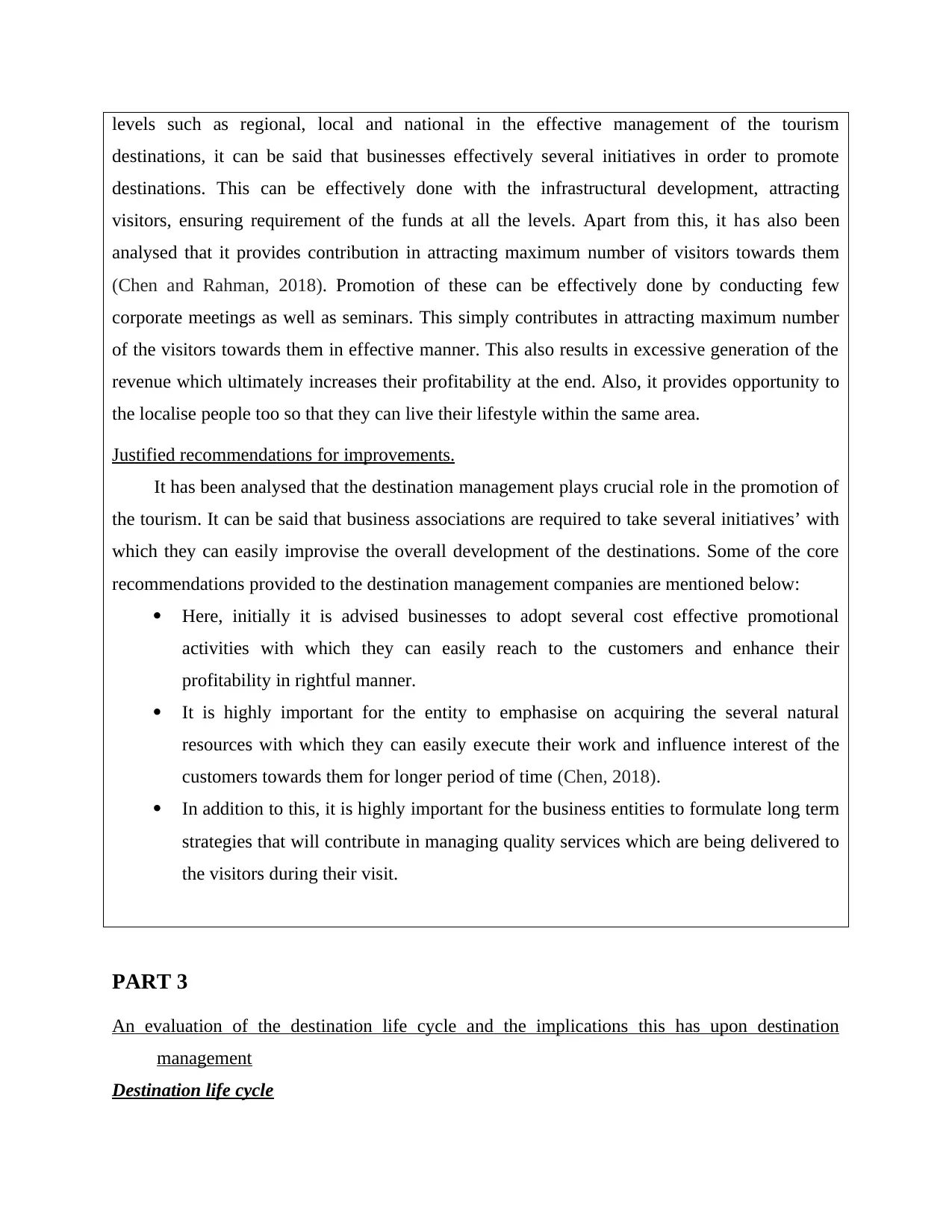
levels such as regional, local and national in the effective management of the tourism
destinations, it can be said that businesses effectively several initiatives in order to promote
destinations. This can be effectively done with the infrastructural development, attracting
visitors, ensuring requirement of the funds at all the levels. Apart from this, it has also been
analysed that it provides contribution in attracting maximum number of visitors towards them
(Chen and Rahman, 2018). Promotion of these can be effectively done by conducting few
corporate meetings as well as seminars. This simply contributes in attracting maximum number
of the visitors towards them in effective manner. This also results in excessive generation of the
revenue which ultimately increases their profitability at the end. Also, it provides opportunity to
the localise people too so that they can live their lifestyle within the same area.
Justified recommendations for improvements.
It has been analysed that the destination management plays crucial role in the promotion of
the tourism. It can be said that business associations are required to take several initiatives’ with
which they can easily improvise the overall development of the destinations. Some of the core
recommendations provided to the destination management companies are mentioned below:
Here, initially it is advised businesses to adopt several cost effective promotional
activities with which they can easily reach to the customers and enhance their
profitability in rightful manner.
It is highly important for the entity to emphasise on acquiring the several natural
resources with which they can easily execute their work and influence interest of the
customers towards them for longer period of time (Chen, 2018).
In addition to this, it is highly important for the business entities to formulate long term
strategies that will contribute in managing quality services which are being delivered to
the visitors during their visit.
PART 3
An evaluation of the destination life cycle and the implications this has upon destination
management
Destination life cycle
destinations, it can be said that businesses effectively several initiatives in order to promote
destinations. This can be effectively done with the infrastructural development, attracting
visitors, ensuring requirement of the funds at all the levels. Apart from this, it has also been
analysed that it provides contribution in attracting maximum number of visitors towards them
(Chen and Rahman, 2018). Promotion of these can be effectively done by conducting few
corporate meetings as well as seminars. This simply contributes in attracting maximum number
of the visitors towards them in effective manner. This also results in excessive generation of the
revenue which ultimately increases their profitability at the end. Also, it provides opportunity to
the localise people too so that they can live their lifestyle within the same area.
Justified recommendations for improvements.
It has been analysed that the destination management plays crucial role in the promotion of
the tourism. It can be said that business associations are required to take several initiatives’ with
which they can easily improvise the overall development of the destinations. Some of the core
recommendations provided to the destination management companies are mentioned below:
Here, initially it is advised businesses to adopt several cost effective promotional
activities with which they can easily reach to the customers and enhance their
profitability in rightful manner.
It is highly important for the entity to emphasise on acquiring the several natural
resources with which they can easily execute their work and influence interest of the
customers towards them for longer period of time (Chen, 2018).
In addition to this, it is highly important for the business entities to formulate long term
strategies that will contribute in managing quality services which are being delivered to
the visitors during their visit.
PART 3
An evaluation of the destination life cycle and the implications this has upon destination
management
Destination life cycle
⊘ This is a preview!⊘
Do you want full access?
Subscribe today to unlock all pages.

Trusted by 1+ million students worldwide
1 out of 18
Related Documents
Your All-in-One AI-Powered Toolkit for Academic Success.
+13062052269
info@desklib.com
Available 24*7 on WhatsApp / Email
![[object Object]](/_next/static/media/star-bottom.7253800d.svg)
Unlock your academic potential
Copyright © 2020–2025 A2Z Services. All Rights Reserved. Developed and managed by ZUCOL.





